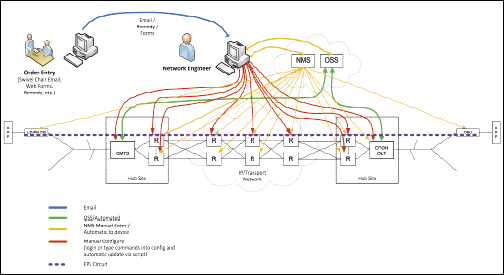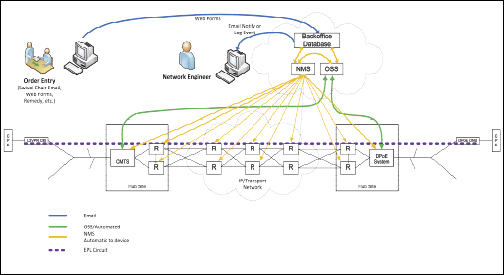Scaling Ethernet Everywhere, Pressing The Business Services ‘Go’ Button
 Business services have been an area of growth for most multiple system operators (MSOs), and it remains an underserved market. The demand for services from competitive sources is strong, and operators have more growth ahead before taking their reasonable share of the market.
Business services have been an area of growth for most multiple system operators (MSOs), and it remains an underserved market. The demand for services from competitive sources is strong, and operators have more growth ahead before taking their reasonable share of the market.
The secret to success with business services — as it has with residential broadband and voice — involves service and product innovation, attention to quality, competitive pricing, customer service and technology innovation.
Although it is the newest set of products to enter this market, Ethernet services are the fastest-growing portion of wireline business offerings. Whether as wholesale transport, Metro Ethernet services or even regional or wide area network (WAN) services, Ethernet services are in demand from large business customers.
Yet MSOs have a challenge. Provisioning of business customers for Ethernet services typically is a manual process. The only systems for end-to-end provisioning are vertical solutions that require hardware from a single vendor. Serving these markets in a sustainable manner, however, calls for greater automation. MSOs can reach that goal by enabling relational variables in their back office and operations support systems (OSSs). These changes will allow them to streamline order entry and configuration, and to grow this business as efficiently as possible.
Ethernet Services
The market for Ethernet services is expanding as the telecom industry standardizes on the Metro Ethernet Forum (MEF) service model using Carrier Ethernet technologies. Ethernet services vary in data rates (typically from 1 Mbps to 10 Gbps or now even 100 Gbps) and in topologies ranging from a simple point-to-point Ethernet, such as MEF Ethernet Private Line (EPL), to Ethernet Virtual Private (EVP)-LAN, which allows a service provider to provide multiple, virtual (V)LANs in a complex switch Ethernet service model across multiple customer sites.
The most economical way for MSOs to provide Ethernet services is over DOCSIS, either DOCSIS with Layer 2 virtual private network (L2VPN) or Ethernet passive optical network (EPON) using DOCSIS Provisioning of Ethernet (DPoE). That works for data rates up to the 10 Gbps aggregate capability of EPON. Beyond those rates, baseband, coarse wavelength division multiplexing (CWDM) and dense (D)WDM solutions provide capabilities to 100 Gbps.
What is needed is a system for automating the end-to-end order entry, provisioning and operations of all of these services. That would be a lot to accomplish all at once, but the industry already has taken the first steps.
IP Provisioning
Understanding the particular requirements of Ethernet, especially as compared to voice or data services, helps to justify the need to add functionality to the back office and OSS.
In the case of high-speed data, the DOCSIS framework establishes a relationship between a cable modem and a cable modem termination system (CMTS). The CMTS is a default router and provides the necessary services without any further provisioning. Although the CMTS is itself manually provisioned (a network engineer configures the equipment), it is possible to automate the provisioning required for each customer’s cable modem.
When the industry added voice to its service portfolio, it maintained the DOCSIS-based provisioning system from high-speed data. All that was required was to add functionality necessary for voice provisioning. As with high-speed data, both Packet Cable 1.5 and 2.0 use IP-based forwarding on a CMTS. Instead of forwarding IP traffic to the Internet, the CMTS forwards traffic to a call management server (CMS) for Packet Cable 1.5 or to a SIP proxy server in Packet Cable 2.0.
Carrier Ethernet Services
Ethernet services are different. You cannot simply send traffic to a default router and then forget about it. Ethernet forwarding must be configured at every element in the Ethernet path. The fundamental challenge of Ethernet, making it different from IP services, is the construction of circuits.
The telecom industry has had longtime solutions for circuit construction, but these tools are geared specifically toward such other technologies as synchronous optical networking (SONET). Moreover, these solutions typically are either vendor-specific or homegrown by telephone companies. Because most of the technologies rely on dedicated capacity in order to provision circuits, the concept of circuit provisioning is tied directly to capacity. In a Carrier Ethernet environment, such a solution is possible. But is it necessary?
As with IP, Ethernet uses a packet (or, more properly, a frame) switched architecture. It has shared forwarding capacity across multiple ports, services and customers. MSOs have no need to “provision” capacity across their IP networks for high-speed data to work. Likewise, they have no need to “provision” capacity across their IP networks to carry Ethernet traffic encapsulated in IP with multiprotocol label switching (MPLS).
Transport
Today, many MSO networks have evolved beyond basic Ethernet or Ethernet over DWDM to converged IP over MPLS networks. These networks carry most if not all products and services for most MSOs. While legacy SONET remains in use for installed services, it is hard to deny that the future of all services leans toward IP over MPLS.
Carrier Ethernet over IP over MPLS is made possible by pseudowire encapsulation (PWE) of Ethernet. Virtual private wireline services (VPWS) is the Internet Engineering Task Force (IETF) standard that covers such point-to-point Ethernet services as MEF EPL (note: Cisco calls VPWS Ethernet over MPLS or EoMPLS). The virtual private LAN service (VPLS) is the standard for MEF ELAN services, both EVP-LAN and EP-LAN.

FIGURE 1: Legacy and Predominantly Manual Provisioning of an EPL Circuit
Apart from these IP transport mechanisms, the Ethernet industry has developed Carrier Ethernet technologies in order to scale Ethernet beyond the limits of standard VLAN technology. Existing Institute of Electrical and Electronics Engineers (IEEE) standards, such as IEEE 802.1ad, have hierarchical VLANs called provider bridging (PB) that support service provider and customer VLAN (S-VLAN, C-VLAN) stacked together. IEEE 802.1ah provider backbone bridging (PBB) provides more extensive scaling with another layer of hierarchy capable of supporting media access control (MAC)-in-MAC encapsulation for backbone bridging.
In the past, VPLS and PBB have mistakenly been considered competitive, because the development of provider backbone transport (PBT) was offered as a technology to avoid IP over MPLS and VPLS. Today, PBT is largely deprecated because of technology and scaling limits. Its primary endorser, Nortel, is no longer in business. IP-based technologies clearly have proven capable of scaling to meet the needs of many services, and Ethernet is no exception. As have their peers in the telco community, MSOs widely have settled on the use of IP over MPLS with VPWS (EoMPLS), with hierarchical (H)-VPLS or VPLS for Ethernet over IP.
The ‘Go’ Button
Hitting the “go” button on mass Ethernet service deployment for business can best be accomplished by taking advantage of the existing back-office and OSS processes and tools in place.
As business services continue to expand for MSOs, the growing ranks of sales, engineering and other professionals in some cases have grown (or will grow) to exceed the staff of professionals delivering services to millions of residential customers. Is it necessary to have more people delivering service to a smaller number of customers?
When it comes to customer support, the answer well may be “yes, that’s what’s required for supporting business customers.” But scaling up the number of engineers required for manual provisioning is not an option. Apart from costs, the rate of turn-ups either already is or will become a bottleneck for growth. At some point, there will be too few engineers to go higher. This skill set already is a rare asset. The solution is automation.

FIGURE 2: Automated Provisioning of an EPL Circuit
The primary difference between Ethernet services and high-speed data and voice is that the Ethernet service is a service constructed between two or more customer end points.
There are two types of order-entry changes required to enable more automation of this end-point-focused service:
Additions to collect the end-point data on a per-customer basis: a relational set of addresses and other location information. Rather than a number of separate entries, these data must be tied together through a relationship by having a common entity or identifier (a key in the database).
Additions to describe the desired virtual relationship between the end-points: in short, a MEF-based model for each possible service according to the primary MEF services, including the derivative private line and virtual private line variations.
The three primary MEF services are E-Line (point-to-point), E-LAN (multipoint-to-multi-point) and E-Tree (rooted multipoint). Parameters required to describe these services are fully described in the MEF specifications. These are not network protocols; they actually are service definitions and descriptions. The success of these specifications lies in their independence from particular network protocol implementations.
Scenarios To Consider
Beyond provisioning, back-office systems (including order entry) also need to evolve to meet the needs of businesses as they change and grow. Consider the following scenarios:
What happens when a business wants to extend its VLAN beyond its own physical locations to attach a partner to its network? How does an operator enter that extension?
MEF includes Ethernet local management interface (E-LMI) in the Type II user network interfaces (UNIs) that allow customers to signal changes into their virtual private LANs themselves. How will that be supported?
How will MSOs connect to each other and to other Carrier Ethernet operators (via so-called External Network-to-Network Interface or ENNI) to provide automated solutions for wholesale orders?
MEF provides an outstanding model for describing Ethernet services. IEEE provides industry standard network protocols that are the foundation for those services. IETF provides the technology and tools for IP-based transport, providing unlimited scaling potential for Ethernet. CableLabs and the MSOs have now developed specifications to automate Ethernet service provisioning.
Final Thoughts
Back-office systems development will not come off the shelf. It is up to MSOs to develop the processes and tools that they need to automate the entry of orders into their database systems and, from there, to tap into the technologies developed around these standards for service automation. The tools and processes for order entry must be built to accommodate various business models for business customers, including models for different types of business sales, services and relationships with wholesalers and other MSOs.
The teams of professionals at Cable and Telecommunications Marketing (CTAM) have been well ahead of this need, developing the templates for bilateral Ethernet service peering. MSOs; and CableLabs has been active in MEF for years, not only adopting the technology, but also contributing to its development. Now is the time for all stakeholders to engage with peers and to develop the remaining business processes.
Automation will allow MSOs to hit the “go” button and rapidly scale business Ethernet. What the industry achieved with high-speed data and voice, it likewise can achieve with business Ethernet.
Victor Blake and Jonathan Tombes are independent industry consultants. Contact them at victorblake@victorblake.com and jtombes@gmail.com.
Table 1: Query by Customer name (Customer = any, show all fields)
| Customer | Street Address | Device MAC | Account # | Services (Coded) | Tags (TLV) | C-VID | … | N |
| Business A | HSD, Voice | |||||||
| Business A | EPL | |||||||
| Business A | EPL | |||||||
| Business D | ELAN | 1 | ||||||
| Business D | ELAN | 1 | ||||||
| Business D | ELAN | 1 | ||||||
| Business D | ELAN | 2 | ||||||
| Business D | ELAN | 2 |
Table 2: Query by Tag (Tag = any, show customer, address, MAC, services, and c-vid)
| Tags (TVL) | Customer | Street Address | Device MAC | Services (Coded) | C-VID |
| Business A | Ethernet | ||||
| Business A | Ethernet | ||||
| Business D | ELAN | 1 | |||
| Business D | ELAN | 1 | |||
| Business D | ELAN | 1 | |||
| Business D | ELAN | 2 | |||
| Business D | ELAN | 2 |
| Customer Name | Tag | C-VID | VID Description |
| Business D | C=1 | C=1: Customer VLAN for Business D ‘Sales’ | |
| Business D | C=2 | C=2: Customer VLAN for Business D ‘Accounting’ |
FIGURE 1: Legacy and Predominantly Manual Provisioning of an EPL CircuitWhat Is DPoE?Types Of Customer QueriesFIGURE 2: Automated Provisioning of an EPL Circuit